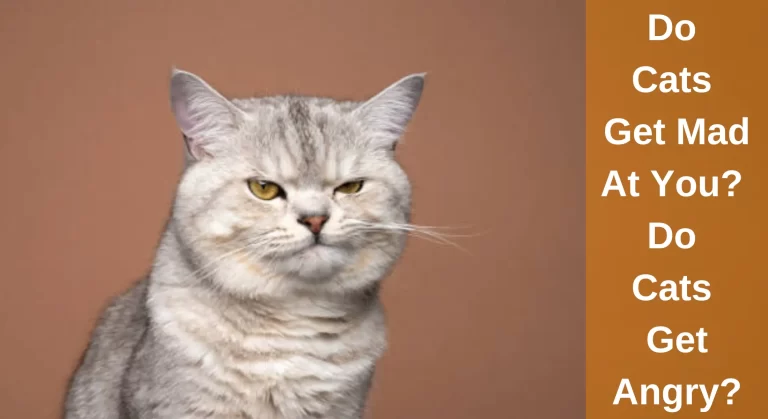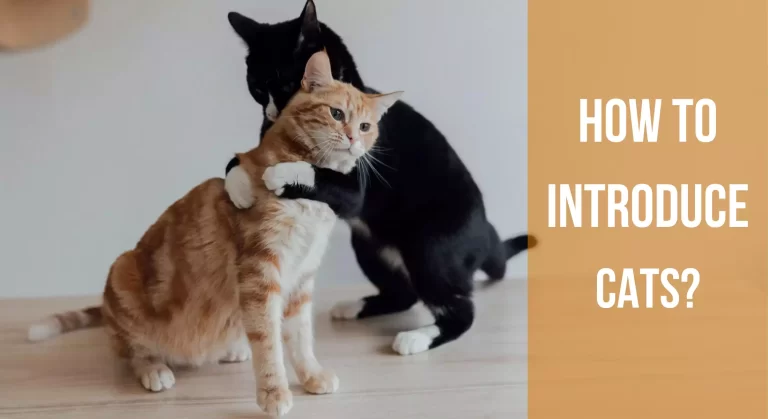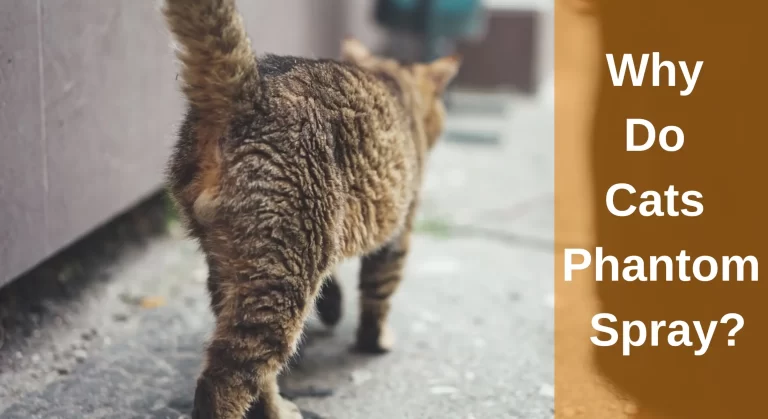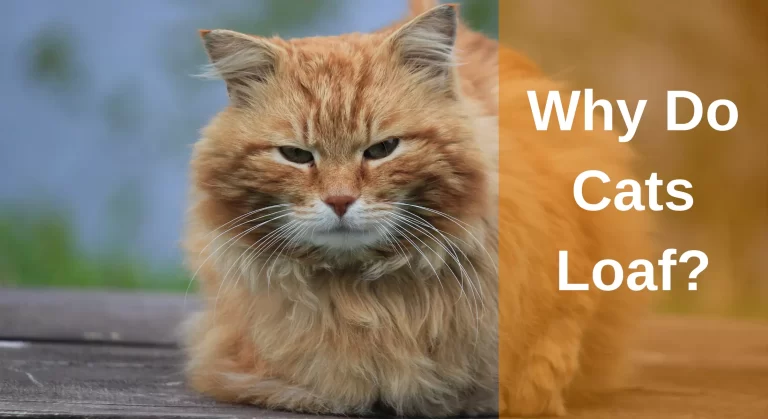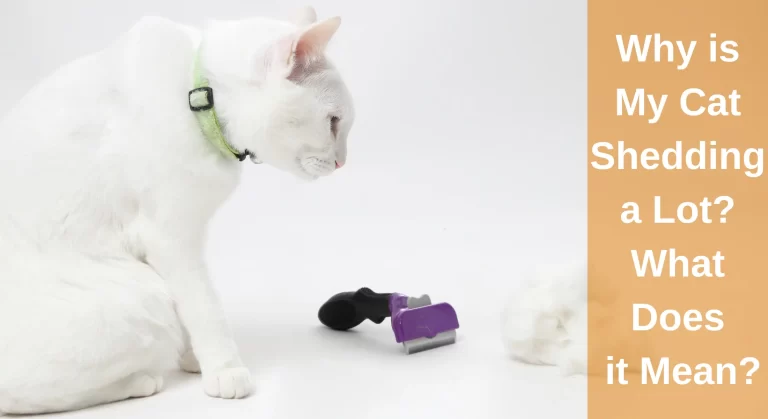Cat Sleeping Positions When Sick: A Guide to Understanding Their Meanings
As a cat owner, I have always been fascinated by my feline friend’s sleeping positions. However, what many pet owners don’t realize is that the way their cats sleep can reveal a lot about their health and well-being. In particular, a cat’s sleeping position can be a telltale sign that they are feeling sick or experiencing discomfort.
A dozing kitten is definitely lovely, but it might also suggest a problem sometimes. As a result, it’s critical for pet parents to grasp frequent ill cat sleeping postures.
Like people, cats will sleep more and have less energy when they are unwell than when they are fit and healthy. Lethargy, on the other hand, might be an indication of illness or despair. When a cat is unwell, sleeping postures might assist discover any underlying disorders or feelings of pain.
In this article, I will discuss various cat sleeping positions, what they mean, and what to do if you notice your cat sleeping in an abnormal position.
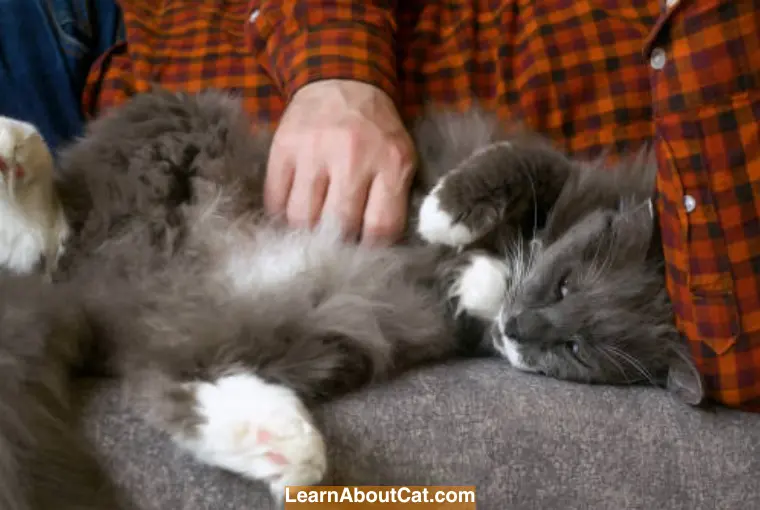
Cat Sleeping Positions When Sick And What They Mean
Knowing your cat’s normal sleeping habits is crucial to understanding when they’re not feeling well. If you notice a sudden change in their sleeping patterns, it’s a sign that something may be wrong. When you understand what’s normal for your cat, you can identify any unusual behaviour and take action accordingly.
1. Sleeping On Their Side
When a cat is lying on its side, it usually indicates that the feline is relaxed and content. This posture suggests that your furry friend has a normal body temperature and is not feeling vulnerable.
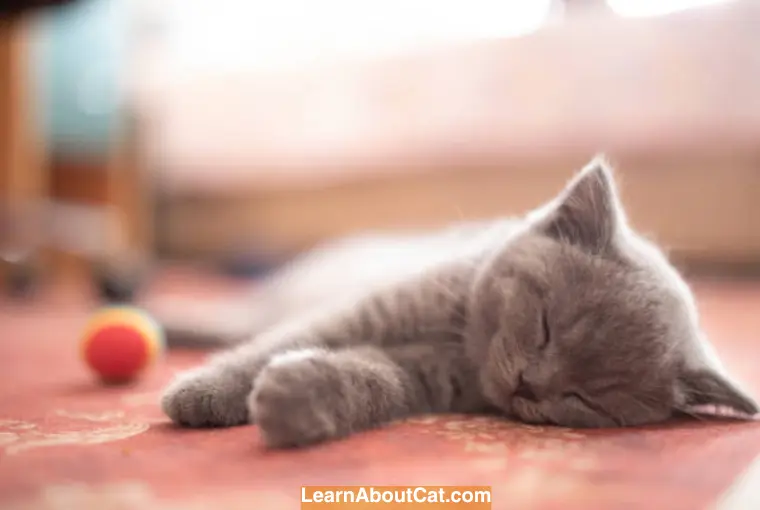
Usually, cats tend to conceal any pain they may be experiencing. So if your cat is unwell, it will probably not sleep in this position.
However, there are exceptions, and side-sleeping may not always be a good sign. If a cat is stretched out on one side, it could indicate that the feline is having difficulty breathing or is experiencing muscle pain.
In such cases, cats prefer to assume this position over others that could put pressure on their lungs, such as lying flat on their stomach or curling up in a ball. If your cat is experiencing breathing issues, you may hear wheezing or deep breathing sounds.
Other warning signs that you should look out for include limping, panting or open-mouthed breathing, difficulty getting into the litter box, and refusal to run or climb.
If your cat consistently sleeps on its side and exhibits any of the symptoms mentioned above, it is best to seek advice from your veterinarian as soon as possible.
2. Cat Loaf Position
When my cat is healthy, she often sleeps in the loaf position, which is when she tucks her front paws under her chest, tails tucked under their belly and her hind legs under her body.
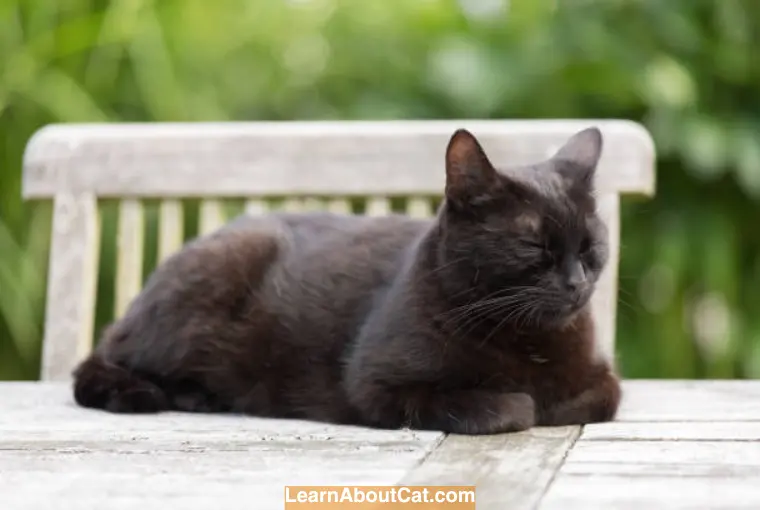
This position allows her to conserve body heat and feel safe. This posture is normal for short naps and is usually an indication that your cat is enjoying a good night’s sleep.
However, when my cat is sick, she might sleep in the loaf position to hide her pain. If your cat is sleeping in the loaf position for an extended period, it could be a sign of discomfort or illness, it might, however, suggest pain in your cat’s paws sometimes.
Common paw problems that could cause this include:
- Wounds
- Ingrown claws
- Foreign objects lodged in paw pads, such as nails, glass, splinters, or seeds.
It is crucial to examine your cat’s paws, particularly if you observe them limping. But remember, it’s better to wait for your fur baby to wake up before attempting to touch their paws. If you come across a wound, it is advisable to seek advice from your veterinarian on the appropriate cleaning and treatment procedures.
3. Sleeping On Their Backs– The Belly-Up Position
The belly-up position is when your cat sleeps on her back, with her belly exposed. It’s typically not a problem if you have an affectionate cat who sleeps on its back at night. In fact, letting its paw pads and tummy be exposed may indicate that your cat is safe and trusts you.
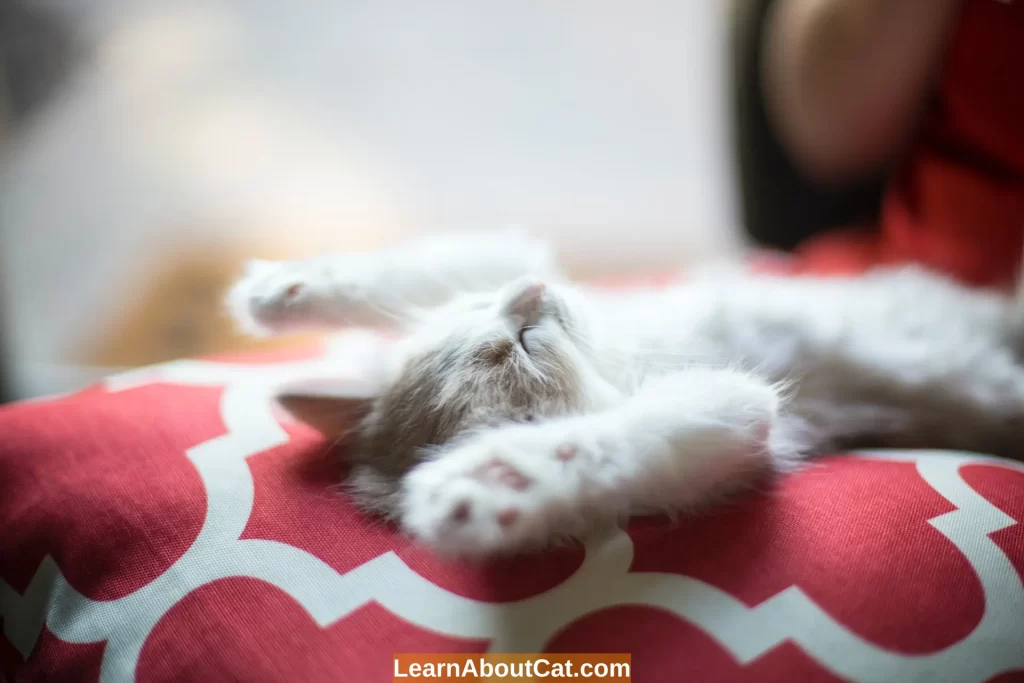
However, if your cat is sleeping flat on its back, it can also suggest that it feels threatened or vulnerable, and it’s keeping its claws and teeth ready for protection.
If your cat shows signs of hiding and aggression for extended periods, it could mean that something is upsetting them, and they need to be on high alert. Check for potential sources of disturbance, such as other animals or people, and try to distance them from your cat.
If you can’t determine the reason for your cat’s behaviour change, it’s best to contact your veterinarian and arrange a check-up.
4. The Curled-Up Position- Sleeping Cat In The Foetal Position
Another common cat sleeping position is the curled-up position. This position is when your cat curls up into a ball, and ears close to their bodies, with her tail wrapped around her body. This position also helps cats retain body heat and feel secure it’s one of the most comfortable resting positions for it.
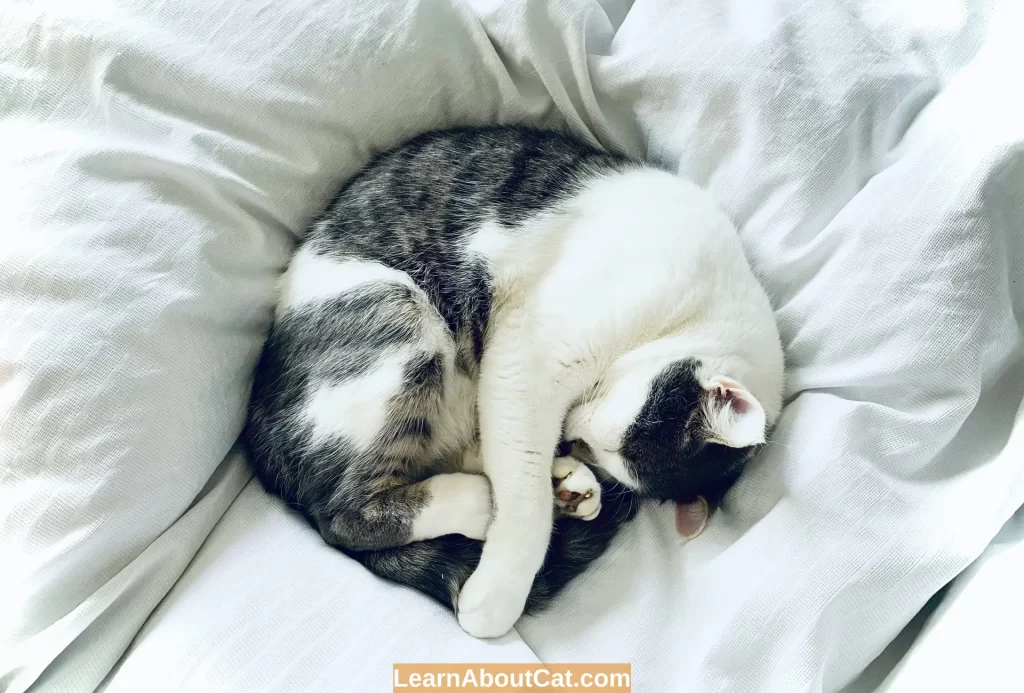
In the fetal position, which is a variation of the curled-up position, a cat’s head is tucked into its chest resulting in a tighter ball. This sleeping posture not only helps keep cats warm but can also protect against any injuries the cat may have sustained.
However, if your cat is sick, she might sleep in the curled-up position to protect her sensitive belly. If your cat is sleeping in this position for a long time, indicating a fever or hypothermia, or it could be a sign of pain or discomfort.
To determine if your cat is struggling to keep warm, make sure that your home’s thermostat is set to an appropriate temperature. The ideal temperature for a cat depends on various factors, such as the cat’s breed, size, age, and health status. As a general rule, try to maintain a temperature of at least 60 degrees Fahrenheit in your home.
5. Position Like Cat Meatloaf – The Hunched Position Sleeping
The cat meatloaf stance is a variant of the loaf position that unwell cats frequently adopt. This is a slumped stance with your cat’s back arched upwards and paws below its body.
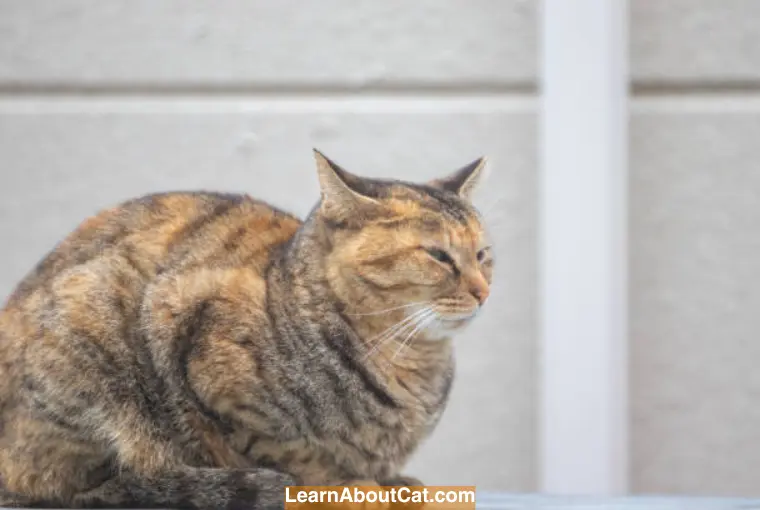
This position can be an indicator of pain or discomfort in the abdominal area, such as an upset stomach or constipation. It can also be a sign of a more serious condition, such as pancreatitis or a urinary tract infection.
If you notice your cat consistently sleeping in a hunched position, it is important to consult with your veterinarian to rule out any underlying health issues.
6. Sleeping On Your Chest
It’s always heartwarming to have your feline friend cuddle with you, especially when they sleep on your chest. The feeling of being loved and wanted is priceless. However, this sleeping position could indicate a cause for concern.
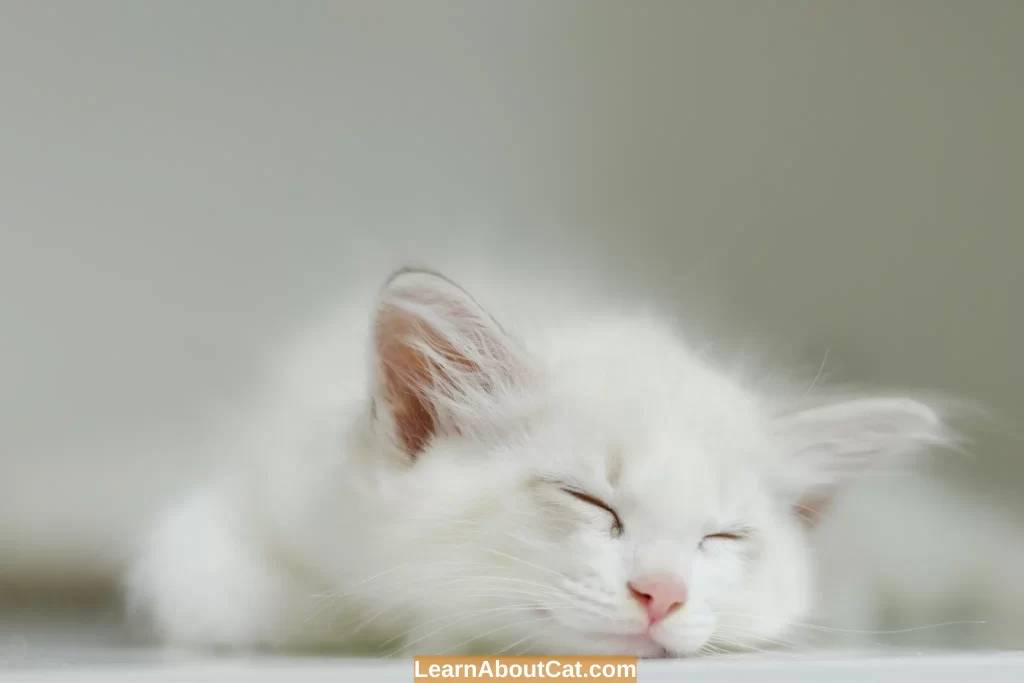
Similar to how humans curl up to keep themselves warm, a cat sleeping on your chest could mean that they’re feeling cold. Our bodies generate heat, making our chest area similar to a radiator or a sunny spot in your home. As cats are naturally drawn to warmth, this could be the reason why they choose to rest on our chest.
While this doesn’t necessarily mean that your cat is struggling to keep warm, it’s always best to check the temperature of your home to ensure your cat’s comfort and prevent the risk of hypothermia.
Additionally, sleeping on your chest could also be a sign that your cat is seeking protection while they sleep. This behaviour is common among cats who live in multi-cat households, and they seek comfort and security from one another.
However, if your cat sleeps on your chest, it could indicate that they’re feeling unwell and vulnerable. Typically, cats tend to avoid showing vulnerability, so seeking protection is a sign that they need care and attention.
7. Sleeping on a Flat Stomach
A cat lying flat on its stomach with its paws stretched out is a common feline posture called “splooting.” This position provides comfort to the cat as it allows them to stretch their hip joints and looks charming as well.

Apart from releasing muscle tension, cats sploot to regulate their body temperature. On hot summer days, cats may find relief by pressing their flat stomachs against a cold surface such as a hard floor.
However, it’s crucial to keep an eye on your cat’s behaviour, especially when lying flat on its back or stomach, to ensure they don’t overheat. If you notice signs of discomfort or excessive warmth, it’s essential to cool them down to prevent heatstroke.
8. The Sphinx Position
The sphinx position is when your cat is lying on its belly with its front legs extended and its back legs tucked under its body. This position can indicate that your cat is feeling alert and ready to pounce.
When your cat is sick, the sphinx position can also indicate that your cat is experiencing discomfort or pain in the lower back or hip area.
9. Paws Outstretched – The Superman Position
The Superman position is when your cat is lying flat on its belly with its front legs extended and its hind legs stretched out behind it. This position can indicate that your cat is feeling playful and energetic.
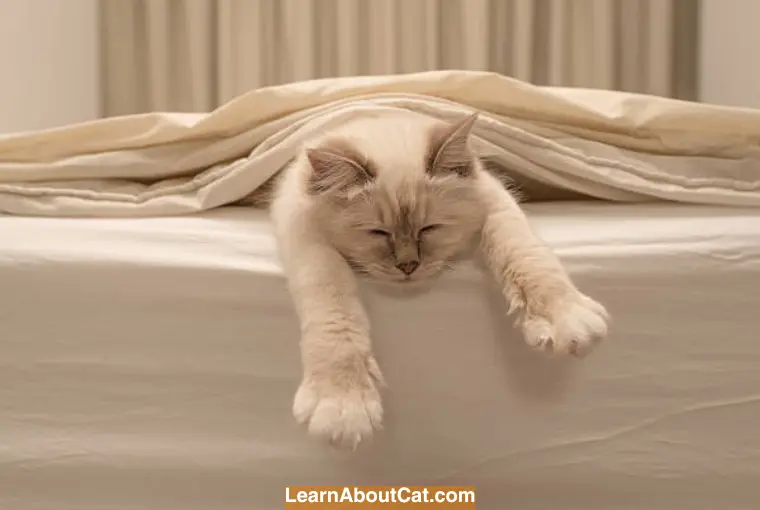
When your cat is sick, the Superman position can also indicate that your cat is experiencing respiratory issues, as it allows your cat to breathe more easily.
10. One Eye Open When Sleeping
Cats are highly intelligent creatures, and one of their unique abilities is the capacity to sleep with their eyes open. This trait, known as unihemispheric slow-wave sleep, allows a cat to rest one half of its brain while keeping the other half fully awake.
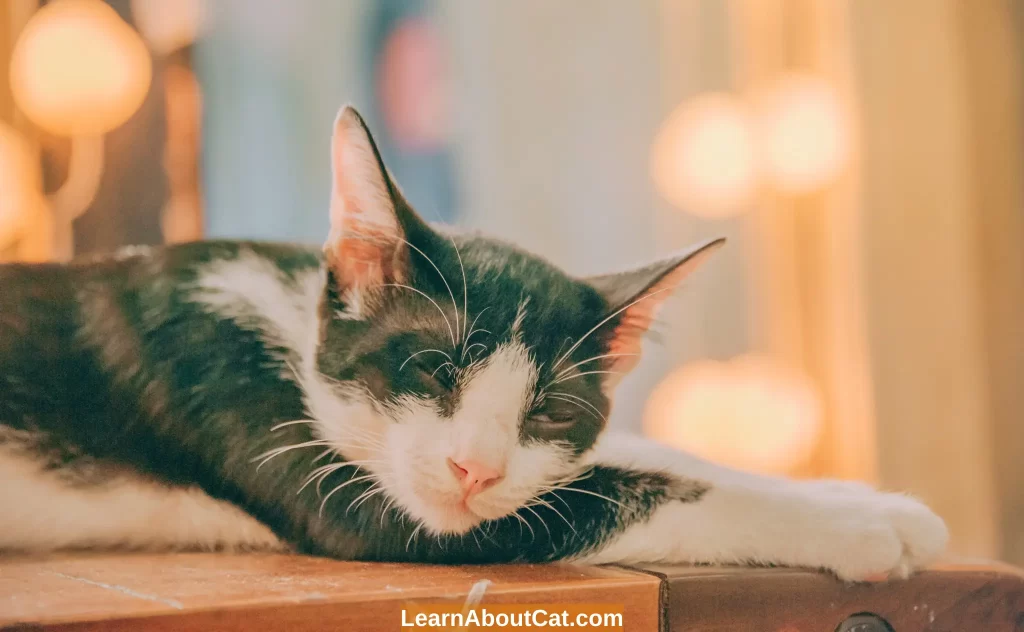
While it may seem odd, it is common for cats to exhibit this behaviour when sleeping.
However, sick cats may also sleep with their eyes open due to eye-related issues, which can present other symptoms such as:
- Redness
- Swelling
- Discharge from or around the eye
- Frequent blinking
One common eye ailment in cats is conjunctivitis, but it could be a more severe condition like corneal ulcers, uveitis, or glaucoma.
If you suspect that your cat has an eye problem, it’s best to contact your veterinarian immediately.
11. Same Posture Sleeping Position
Cats are known for their love of sleeping, and they can do it in all sorts of positions, from curled up tightly to lying on their side. However, if you notice that your cat is sleeping in the same position all the time, it could be a sign that something is wrong with its health.
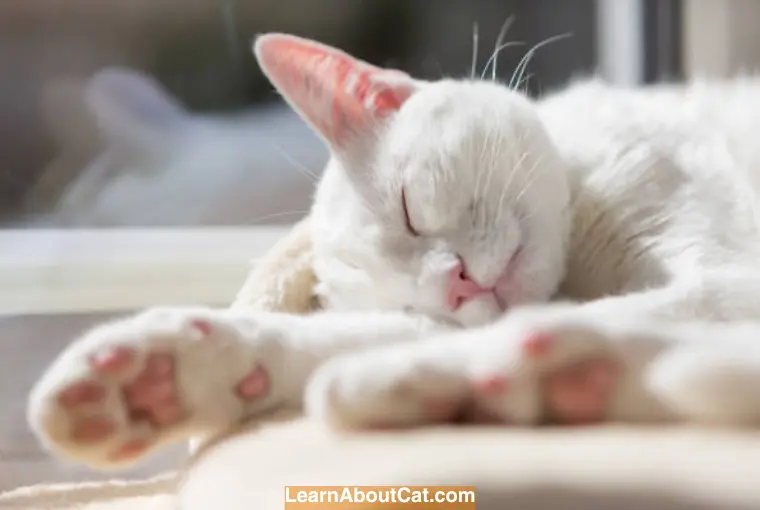
For example, if your cat is always curled up in a ball in a warm area, it may indicate that they are constantly feeling cold. On the other hand, if your cat switches between different sleeping positions, there may not be any cause for concern.
Similarly, if your cat is sleeping with their eyes open all the time, it could indicate that they have an eye condition rather than practising unihemispheric sleep.
Therefore, it’s crucial to keep an eye on your cat’s sleeping habits, especially if it’s accompanied by other signs of illness. Knowing your cat’s typical habits, routines, and activities can help you spot any potential problems earlier and increase the chances of successful treatment.
12. Sharing A Bed With Other Cats
If you have several cats, seeing them curled up together is quite sweet. Cats raised in the same home frequently create an unshakable relationship. They will slumber and groom one another.
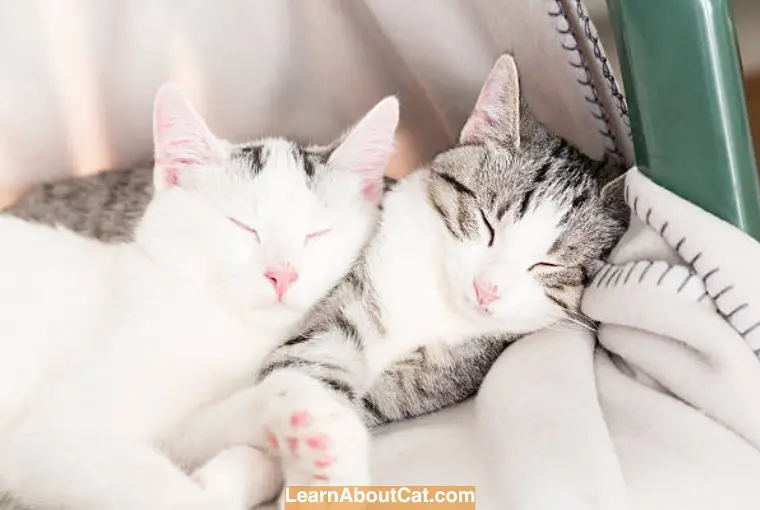
While it’s not unusual to find two cats sleeping together, if one of them is awake while the other is asleep, it could indicate an underlying issue. This behaviour may suggest that the sleeping cat is relying on the other for protection.
Although cats are capable of displaying affection towards their feline companions, they are also territorial and independent animals. Therefore, if one cat is seeking help from another, it could indicate a desperate need for protection.
13. Prayer Like Position
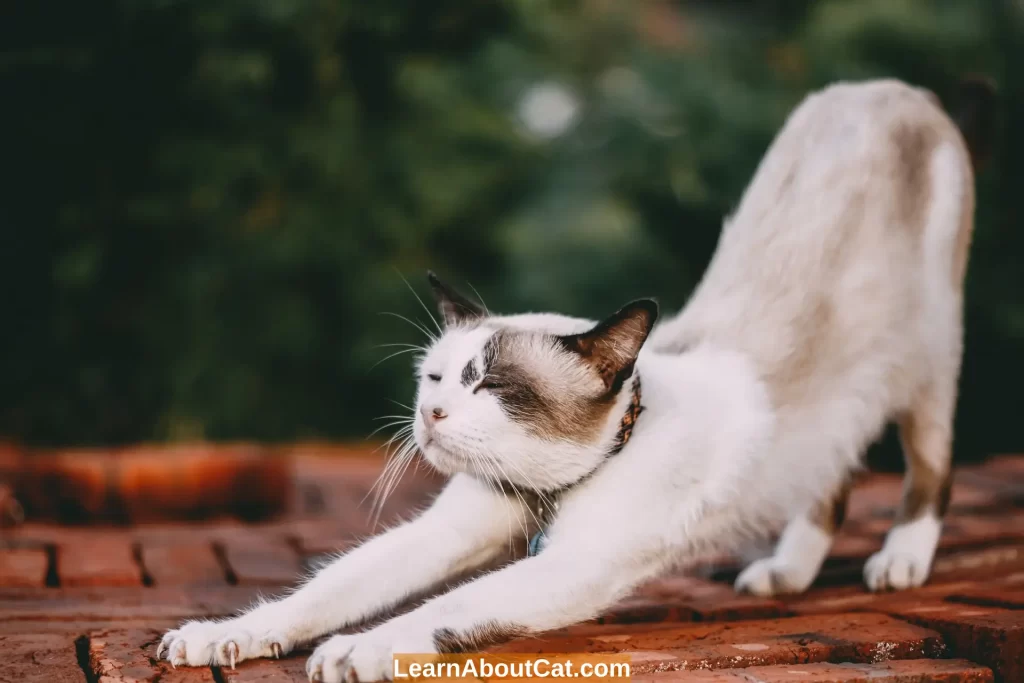
The prayer posture occurs when a cat’s chest is near the ground and its back legs are in the air. Although cats will not sleep in this position, it can suggest illness and should be avoided.
The primary cause of this aberrant posture is feline peritonitis. Cats suffering from peritonitis are more inclined to sleep curled up in order to protect their stomach.
Other Signs of Cat Illness
Activity Levels Have Dropped
Lethargy in cats is frequently an indication of a problem. Your cat resting more frequently, being less active, or has less overall energy. Low energy is frequently caused by fevers, infections, or general illness. Other causes of your cat’s low energy levels might include discomfort rather than tiredness.
Changed Grooming Behaviour
When self-grooming ceases among cats, it indicates that something is amiss. A lack of grooming is frequently caused by your cat being agitated. It might, however, be an indication of something more catastrophic.
When senior cats cease grooming, they may develop arthritis. This is when their joints swell and stiffen, and contorting their bodies into the strange postures required to clean themselves all over may cause agony.
Changes in Appetite
Because unwell cats may eat more or less than usual, or be more or less thirsty than usual, any change in appetite or thirst should be taken seriously. Cats with dental issues may appear to be finicky eaters. Cats with metabolic illnesses such as diabetes mellitus or hyperthyroidism may have a voracious appetite and excessive thirst.
Cats suffering from liver or renal illness usually lose their appetite while increasing their thirst. Anorectic cats are more likely to get a urinary tract infection.
Vocalisation That Is Excessive
Excessive vocalisation, on the other hand, is a red flag. Your cat’s excessive meowing might be their method of communicating that they are ill or in discomfort. You could also notice your cat hissing at you and other family members or purring strangely.
Messy Coat and Shedding
Unhappy cats do not groom themselves well. As a result, a dirty or oily coat, fur mats, or clumps of loose hair are common. In certain circumstances, you will notice a difference in the sheen of the coat or an increase in the amount of dandruff.
Excessive grooming might be a reaction to a skin disease like allergies, a parasite like fleas, mites, or ringworm, discomforts like arthritis or a bladder problem, or a stress response.
Litter Box Problems
There are several litter box troubles that might arise, as well as a long list of probable medical disorders or injuries behind these issues.
Personality Transitions
Every cat has a distinct and endearing personality. Some are bold and loud, while others are frightened; some prefer to hide beneath lap cats and are quite docile, while others can be more independent and violent if mishandled. If a normally confident cat is suddenly hiding more, reacting more to loud noises, and becoming more frightened, they are most likely stressed out by a change in its surroundings or unwell.
Is There Anything Else Odd Going On In Your Cat?
In a healthy cat, excessive salivation, any discharge from the nose, foul breath, debris in the ears or strange odour from other regions of the body are not typical. Vomiting, especially of clear frothy fluid, is grounds for concern.
Pale eyes, skin or gums may indicate anaemia, whereas a yellow hue denotes jaundice and a bluish tint indicates an oxygen deficiency. Even a few hours’ delay in receiving treatment for certain conditions can be deadly.
Check Out: Why Do Cats Get In Your Face While You Sleep?
Frequently Asked Questions
In sick cats what changes in breathing should be checked?
Breathing problems, such as panting, shallow breathing or mouth breathing might indicate an airway or lung illness. Cats suffering from respiratory problems typically sleep with their heads and necks extended. As a result, such cats are unable to sleep in a regular position.
Should I be worried if my cat is sleeping more than usual?
It depends on the individual cat’s normal sleeping habits. If your cat usually sleeps a lot, then there’s no need to worry. However, if you notice a sudden increase in sleeping time, it could be a sign of sickness or discomfort.
Can my cat’s sleeping position change as they age?
Yes, as cats age, their sleeping positions may change due to joint pain, arthritis, or other age-related health issues.
Is it normal for my cat to sleep with their eyes open?
No, it’s not normal for cats to sleep with their eyes open, and it could be a sign of discomfort or illness. If you notice this behaviour in your cat, it’s best to consult with a veterinarian.
Should I wake my cat up if they are sleeping in an unusual position?
It’s generally not necessary to wake your cat up if they are sleeping in an unusual position, but you should monitor them closely and seek veterinary care if you notice any changes or signs of illness.
What does it mean when a cat sleeps with their paws over their eyes?
When a cat sleeps with their paws over their eyes, it indicates that they want to be left alone and are in a light sleep.
What should I do if I notice my cat sleeping in an abnormal position?
The first step is to observe your cat’s behaviour. If they are eating, drinking, and using the litter box normally, it may not be a cause for concern. However, if you notice any other unusual behaviours, it’s best to take them to the vet.
What if my cat’s sleeping position does not match any of the described positions?
Cats can have various sleeping positions, and not all of them may fit into the standard categories. If your cat’s sleeping position does not match any of the described positions, it may not necessarily mean anything significant. However, if your cat seems uncomfortable or restless during sleep, it is best to observe them closely and seek advice from a veterinarian if needed.
Is it safe for my cat to sleep with me when they are sick?
It is generally safe for your cat to sleep with you when they are sick, as long as they are not contagious. However, it is essential to provide a separate sleeping area for your cat if they are contagious, as certain illnesses can be transmitted between cats and humans. Additionally, if your cat has a weakened immune system, it is best to consult with a veterinarian before allowing them to sleep with you.
How long should I observe my cat’s sleeping positions before contacting a veterinarian?
If your cat’s sleeping position seems unusual, it is best to observe them closely for a day or two to see if the behaviour persists. If your cat seems uncomfortable or in pain, or if they exhibit other symptoms such as loss of appetite or lethargy, it is best to contact a veterinarian as soon as possible
Conclusion
In conclusion, cats have various sleeping positions that can indicate their level of comfort, mood, or health. It is essential to observe your cat’s sleeping positions regularly to understand their sleeping habits and notice any changes that may signal illness or discomfort.
Keeping this in mind, the frequency of certain sleeping positions, as well as other changes in cat behaviour and body language, can inform us if our cats are in discomfort. These factors are meaningless on their own, but when combined, they can help you evaluate whether or not your cat is content.
Related Posts:
Who is Isabella?
My name is Isabella, and I am a dedicated and knowledgeable cat enthusiast. With years of experience caring for cats and a deep love for felines, I made a mission to help other cat lovers navigate the challenges of cat ownership.

